American Perceptions of GMOs

They’re a menace lurking in America’s grocery aisles, ready to subject your body to untold risks. Or they’re a breakthrough in the fight against food scarcity, boasting serious environmental benefits as well. If you’ve tried to keep track of public debate about genetically modified organisms (GMOs), you’ve likely encountered some version of these incompatible perspectives. If you haven’t, you may just be wondering what that term actually means.
We surveyed over 1,000 Americans about their knowledge and opinions of GMOs – living things with DNA altered by scientists. Our results revealed some intense feelings, but also much uncertainty about the finer points of the debate regarding these foods. One in 10 respondents was unsure what GMO stood for, and less than 43 percent understood that organic products aren’t genetically modified.
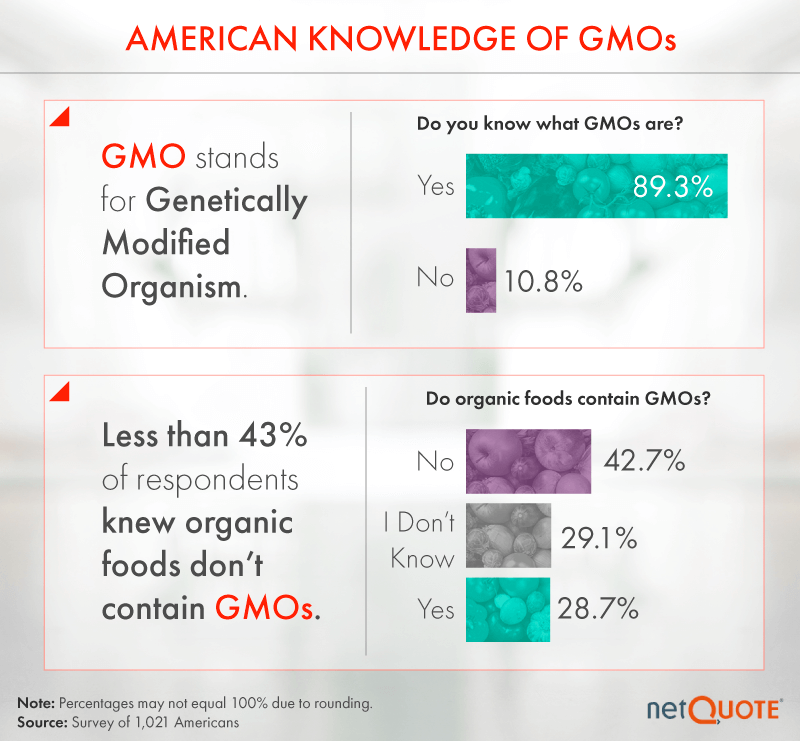
On the subject of GMOs, many are impassioned, others are uninformed, and some folks are both at once. To learn where Americans really stand in this ongoing debate, keep reading.
Thoughts on GMOs
Though a slim majority of respondents felt GMOs had no effect on human health, a sizeable cohort had serious concerns. More than 4 in 10 Americans we surveyed considered genetically modified foods to be more harmful than goods untouched by scientific intervention, and less than 6 percent claimed GMOs were the healthier choice. Alarm was particularly evident among baby boomers, of whom nearly 50 percent expressed moderate or extreme concern about GMOs. Because GMOs first emerged as recently as the 1990s, this older generation may wistfully recall a time before they were widely used.
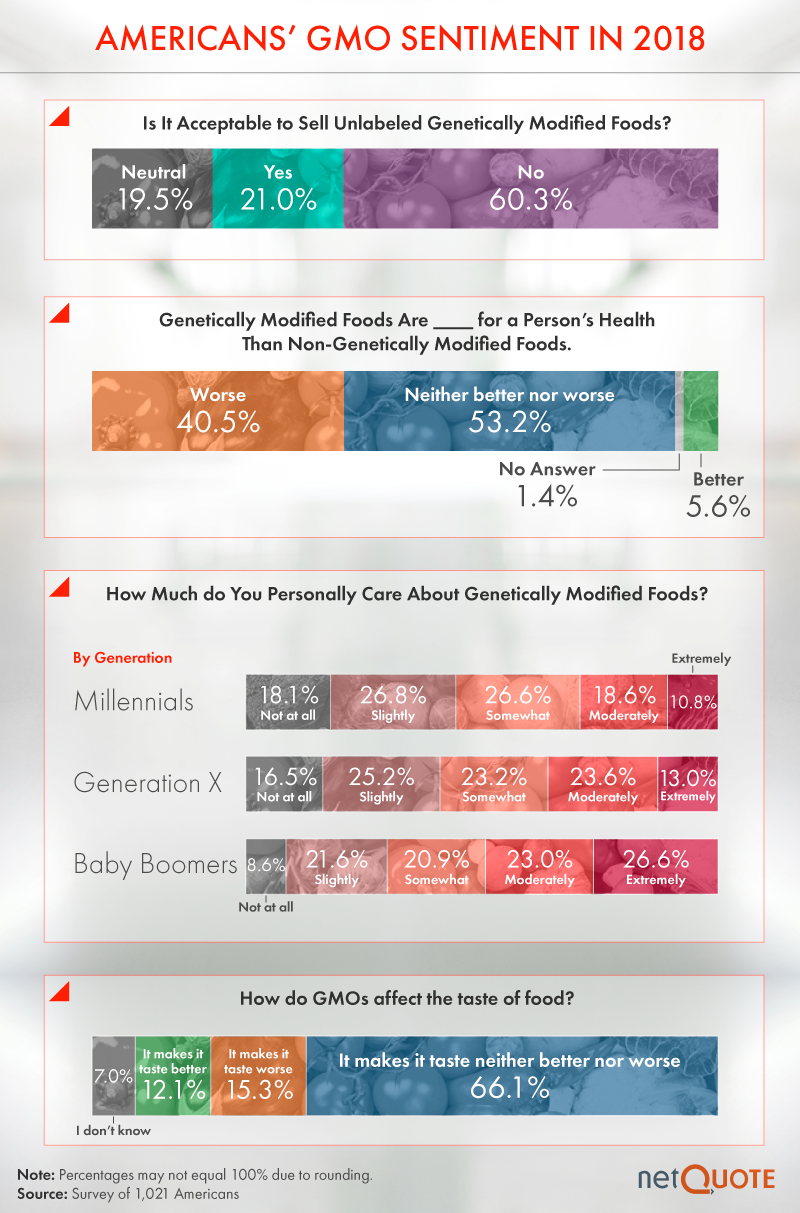
Americans struggle to detect GMOs in products on the basis of taste alone: About two-thirds of respondents said they couldn’t taste any difference between GMO foods and unaltered alternatives. This inability to distinguish by taste may explain the emphasis our respondents placed on labeling GMO content.
Whatever their personal feelings about the risks of GMOs, more than 60 percent supported a labeling requirement on relevant products so consumers can choose to steer clear of them. When asked if such a requirement exists already, however, respondents offered quite mixed opinions – or simply admitted their uncertainty.
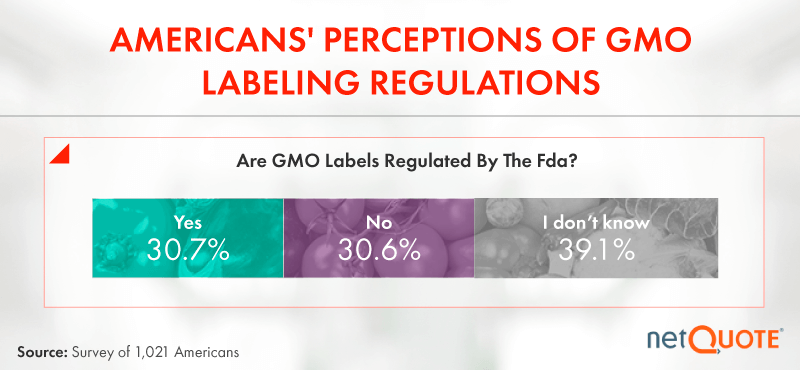
The public’s evident confusion may stem from the FDA’s slow pace of implementation in regard to genetically modified foods. While a bill mandating GMO labeling did become law in 2016, the FDA has struggled to establish and implement precise standards and requirements for manufacturers to meet. Additionally, many brands have adopted labels declaring their products GMO-free, deeming it important in earning consumer trust.
Critics, however, suggest these labels are a superfluous marketing ploy designed to exploit consumers’ fears.
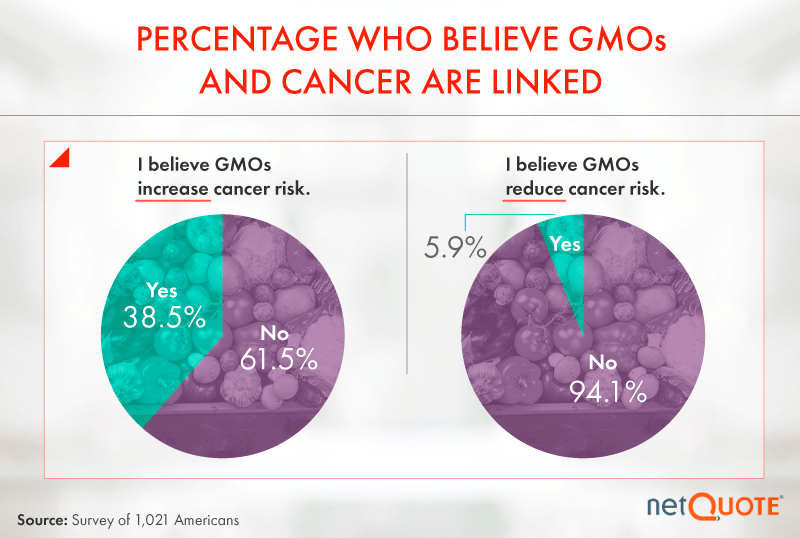
Among various concerns raised about GMO consumption, none is more severe than a potential link with cancer. And though the medical establishment notes there is insufficient evidence to connect GMO products with increased cancer risk at this time, plenty of Americans feel convinced otherwise.
Nearly 39 percent of respondents believed GMO foods could increase cancer risk, whereas less than 6 percent felt they might help prevent it. Interestingly, anti-cancer GMOs are rapidly becoming reality in the developing world, where they can be used to fight toxic substances sometimes found in common foods.
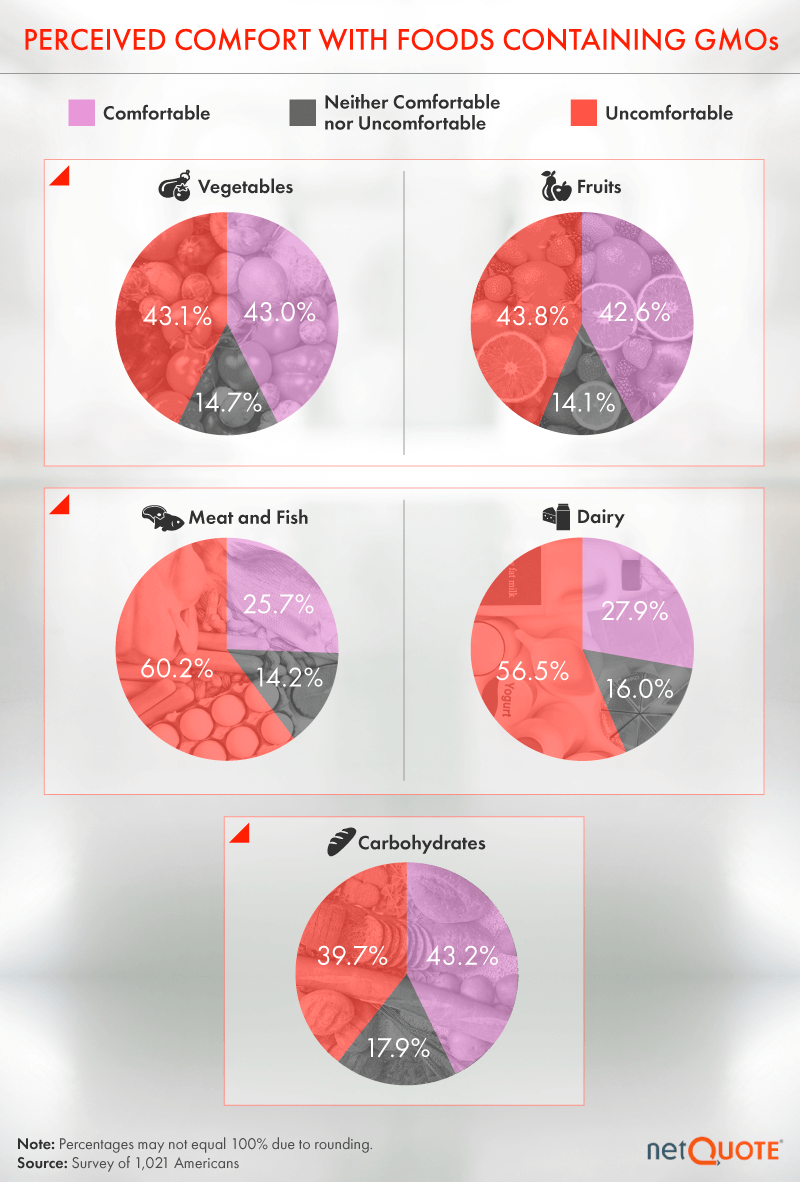
Our findings indicate that GMO fears are most pronounced with regard to animal products. More than 56 percent of respondents felt uncomfortable with GMOs in milk and dairy, and 60 percent were concerned with genetically modified meat or fish.
Despite this apparent public concern, biotechnology appears poised to further disrupt these food categories. Deep-pocketed investors have recently poured money into startups that produce milk and meat in labs, leaving animals out of the process entirely.
Our respondents were somewhat more comfortable with genetically modified fruits and vegetables. Perhaps that’s because the practice is already so widespread in produce manufacturing: According to the FDA, 93 percent of soybeans and 88 percent of corn produced in America is the product of genetic engineering.
Respondents were even more amenable to GMOs use in carbohydrates like wheat and other grains. Actually, the prospect of wheat engineered to exclude gluten has recently generated great excitement among food scientists who hope to make bread products available to those with gluten allergies.
GMO Decisions
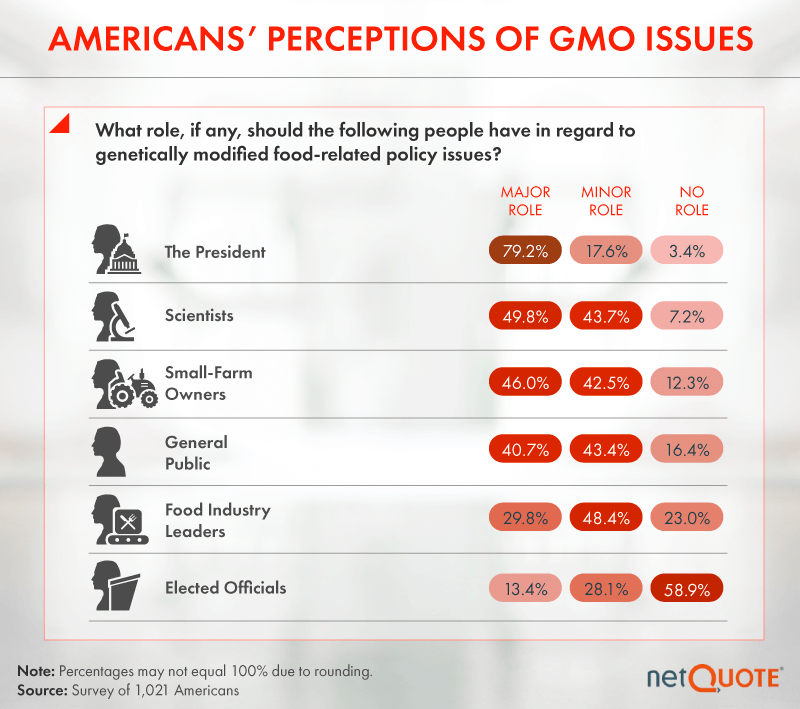
If comfort with genetically modified foods varies so significantly, which authorities should dictate the terms of their regulation? Respondents across the political spectrum were most likely to suggest the president should play a major role in determining GMO policy, perhaps because the FDA falls under the umbrella of the executive branch. A sizeable percentage of people felt scientists and small-farm owners should also exert major influence over the regulation of GMOs.
Our data suggest greater suspicion regarding the influence of major corporations on GMO policy. Actually, the subject has caused significant conflict among giants of the grocery and food manufacturing industries, with some corporations supporting stricter labeling requirements and others actively resisting them. Respondents tended to be most skeptical of another group, however: elected officials. Political scientists have recently noted a surge in food-related political activity nationwide, but many efforts intentionally bypass appeals to elected officials, utilizing ballot box initiatives and referendums instead.
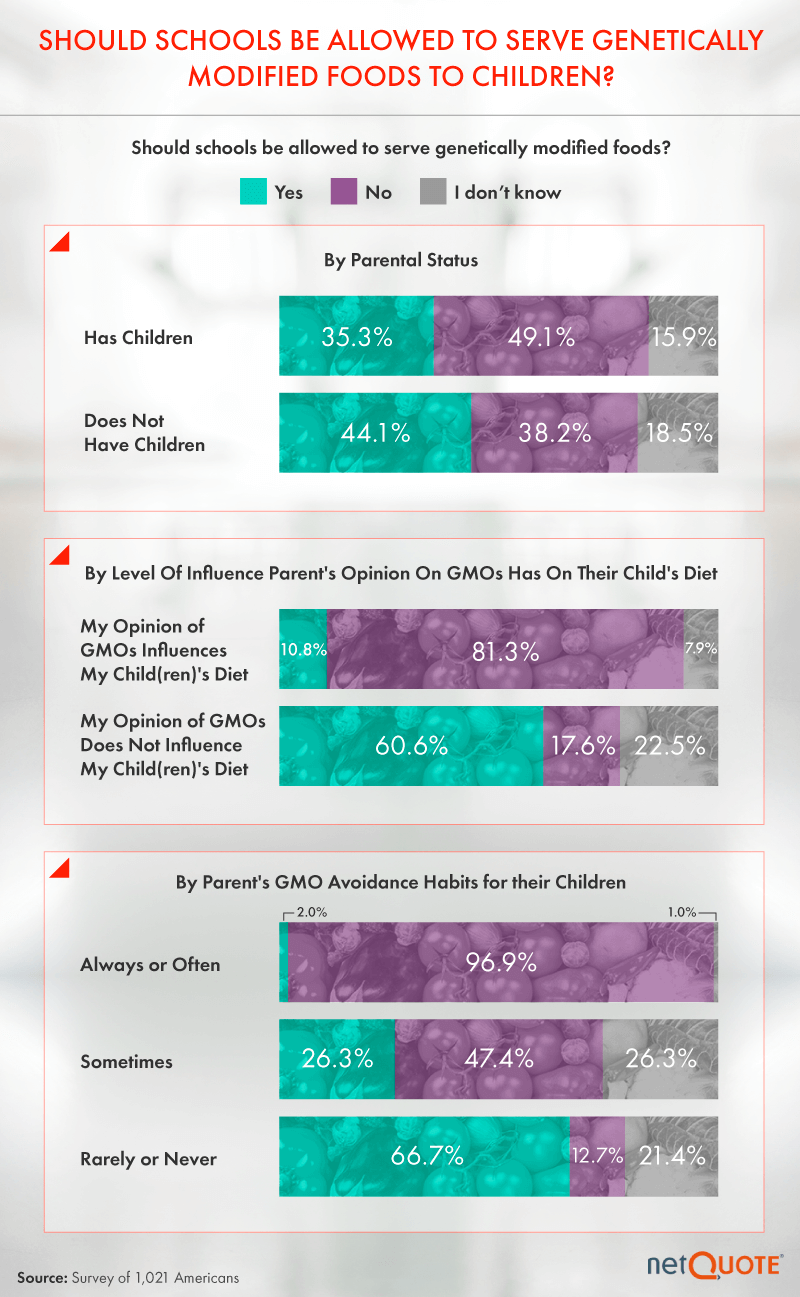
The content of meals served in public schools has long caused political debate. In fact, the Trump administration recently relaxed nutrition regulations implemented under the Obama administration. On the question of including GMOs, parents were less enthusiastic than peers without children, with nearly half stating they should not be permitted. This sentiment was even stronger among those whose own GMO feelings influenced what they fed their kids.
Of those who typically excluded GMO foods from their own children’s’ diets, nearly all felt that that no such food should be served in schools. Conversely, two thirds of parents who rarely or never kept GMO products from their kids said schools should be allowed to serve them. Clearly, the subject prompts divergent opinions, and even judgement of those with differing opinions. Some parents report feeling shamed by others when they feed their kids anything but organic products.
Wellness Beyond What We Eat
Our varied findings suggest a clear conclusion: The American debate about the risks and benefits of genetically modified foods rages on. Fueled by passionate differences of opinion and significant uncertainty, the public conversation about GMOs will likely continue unabated. In the absence of broad consensus, it falls to individuals and families to seek as much information as possible and make their own dietary decisions accordingly. As we do, however, it’s best to be respectful when others choose differently. We may not be what we eat – but it can be difficult to take judgments aimed our diets anything but personally.
Other subjects relating to our health can feel just as intimate, including access to the care we need. Yet many Americans feel their insurance coverage is too limiting or too expensive, a one-size-fits-all approach that falls short. Let netQuote help you consider your options with coverage and quotes personalized to your preferences and circumstances. With the right information and offerings, you can protect yourself and the ones you love.
Methodology
We collected responses from 1,021 Americans through Amazon’s Mechanical Turk. Fifty-one percent of our respondents were women, and 49 percent were men. Participant ages ranged from 18 to 82 with a mean of 37 years old.
Participants were excluded from analysis if they failed to answer attention-check questions throughout the survey. Percentages that do not equal 100 percent are due to rounding and in some cases, variables were combined (ie: “Rarely” and “Never”).
Fair Use Statement
Just like good food, this content is best when shared with others. Accordingly, feel free to use our images and info for your own noncommercial purposes. When you do, please link back to this page to credit our team appropriately.
